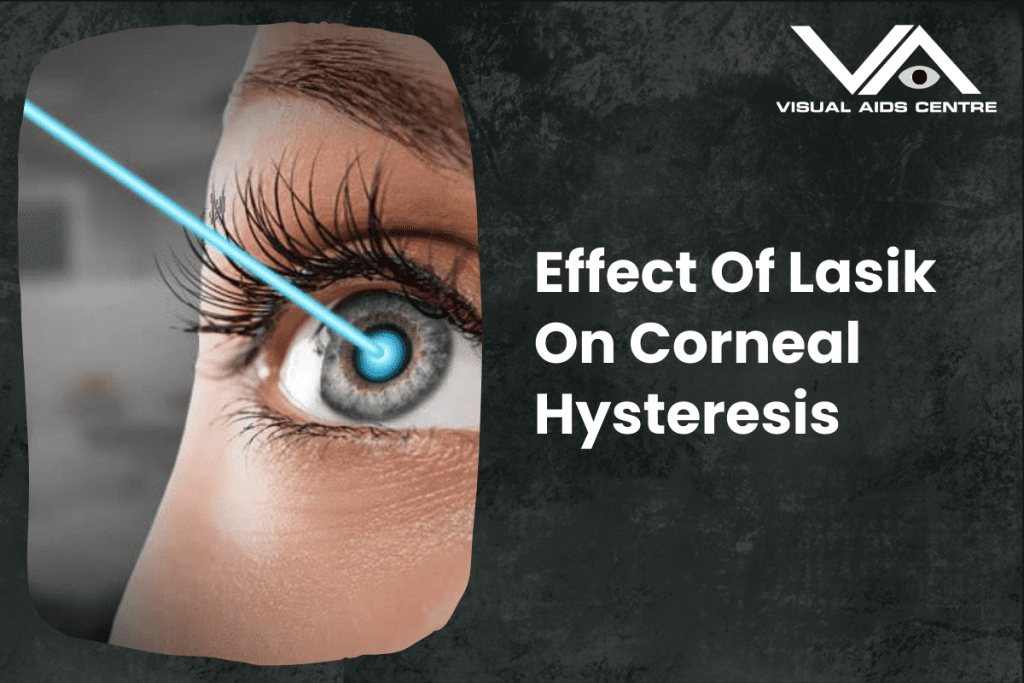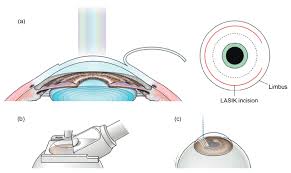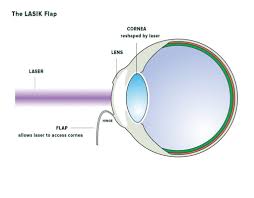Table of Contents
ToggleLASIK surgery has a direct impact on corneal hysteresis (CH), often reducing its value due to the changes it causes in the corneal structure.
Corneal hysteresis serves as a biomechanical marker, reflecting the cornea’s ability to absorb and dissipate energy, and understanding its alteration post-LASIK is crucial for both surgeons and patients.
Corneal biomechanics, including hysteresis, play a vital role in maintaining the stability, shape, and function of the cornea. LASIK, while revolutionary for vision correction, involves altering the corneal tissue to reshape it and improve refractive errors. This intricate procedure inevitably modifies the biomechanics of the cornea, leading to decreased CH values. But what does this mean for LASIK patients? Here’s an in-depth exploration to help you understand.

What is Corneal Hysteresis?
Corneal hysteresis (CH) is a measurement of the cornea’s viscoelastic properties—its ability to resist deformation and return to its original state after being subjected to pressure. It is both a biomechanical and dynamic property that reflects how the cornea absorbs and dissipates energy under stress.
- CH is typically measured using specialised tools like the Ocular Response Analyser (ORA).
- High CH values indicate a healthier, more resilient cornea, whereas lower values suggest structural weakness.
Understanding CH is essential for assessing corneal strength and rigidity. It plays a vital role in diagnosing and managing conditions like glaucoma and keratoconus and in preoperative assessments for refractive surgeries like LASIK.
What Happens to Corneal Hysteresis During LASIK?
LASIK, or laser-assisted in situ keratomileusis, is a widely adopted procedure for treating refractive errors such as myopia, hyperopia, and astigmatism. The surgery involves two main steps:
- Creating a corneal flap to access the stroma.
- Reshaping the corneal stroma using an excimer laser before repositioning the flap.
During the laser ablation process, the surgery alters the corneal thickness and structure, removing tissue to reshape the cornea. This reshaping directly affects the corneal biomechanical properties, most notably CH.
Reduction in Corneal Hysteresis
LASIK consistently lowers CH values, which is largely attributed to the thinning of the corneal stroma during the procedure. Since CH depends on corneal thickness and structural integrity, the reduction in stromal layers weakens the cornea’s ability to rebound after deformation.
Studies have shown:
- A noticeable decrease in CH post-LASIK, often measurable within a few weeks of surgery.
- The reduction is proportional to the amount of tissue ablation and pre-surgery CH levels.
Factors Influencing CH Reduction
Several factors influence the extent of CH reduction following LASIK:
- Preoperative Corneal Properties: Thinner or weaker corneas may experience a more significant decline in CH.
- Degree of Tissue Ablation: Higher degrees of myopia correction demand more tissue removal, resulting in greater CH reduction.
- Type of Laser and Techniques Used: Differences in laser settings and surgical techniques can lead to variations in post-operative CH levels.
Clinical Implications of Reduced Corneal Hysteresis
The reduction of corneal hysteresis after LASIK carries several clinical implications, some of which may be of significant concern for long-term eye health.
Risk of Ectasia
A decreased corneal hysteresis is often associated with increased susceptibility to corneal ectasia, a progressive thinning and bulging of the cornea. LASIK patients with reduced CH are considered at higher risk, particularly in cases where:
- The residual stromal bed thickness is insufficient (less than 250 microns).
- The patient has undiagnosed or subclinical keratoconus.
Impact on Glaucoma Diagnosis and Management
Reduced CH post-LASIK can complicate the diagnosis and monitoring of glaucoma. CH is a vital parameter in the measurement of intraocular pressure (IOP), and lower CH values may result in inaccurate IOP readings. For LASIK patients:
- Precise methods are required for glaucoma risk assessment.
- Regular monitoring of post-surgical CH and IOP is crucial to detect abnormalities over time.
Influence on Corneal Stability
Patients with significantly decreased corneal hysteresis may experience long-term biomechanical instability. This can potentially lead to complications such as fluctuations in visual acuity or unexpected refractive changes after surgery.
Mitigating CH Reduction in LASIK
While reductions in corneal hysteresis following LASIK are almost inevitable, surgeons can take steps to mitigate risks and maximise corneal stability.
- Preoperative Assessment: Thoroughly evaluating CH values pre-surgery and identifying patients with inherently weak or thin corneas is crucial for candidate selection.
- Residual Stromal Bed Management: Ensuring the preservation of an adequate stromal bed can minimise the biomechanical disruption caused by LASIK.
- Advanced Techniques: Incorporating techniques like SMILE (Small Incision Lenticule Extraction), which preserves more corneal integrity, can result in better post-operative CH measurements.
- Post-operative Monitoring: Regular follow-ups to measure CH and detect early signs of complications such as ectasia or biomechanical weakening are essential.
How Does CH Recovery Differ from Other Corneal Properties?
It’s important to note that while corneal hysteresis decreases after LASIK, certain biomechanical properties, such as corneal curvature, may stabilise over time. However, CH does not typically return to preoperative levels, as the structural change is permanent.
Other vision correction procedures, such as PRK (photorefractive keratectomy) and SMILE, may have varying impacts on CH due to differences in surgical approach. For example:
- PRK does not involve a corneal flap but still alters CH due to stromal ablation.
- SMILE is reported to cause less disruption to CH compared to LASIK, but the evidence is still limited.
Long-Term Considerations for Patients
While LASIK offers life-changing vision correction, understanding the long-term biomechanical effects is vital, especially for patients with borderline CH or pre-existing conditions. Here’s what LASIK patients should keep in mind:
1. Understand the Procedure:
Recognise that while LASIK is beneficial, it comes with changes to your corneal biomechanics. Discuss these alterations with your ophthalmologist and understand how they relate to your eye health.
2. Assess Personal Factors:
Patients with thin corneas, high refractive errors, or family histories of keratoconus should approach LASIK with caution. Alternatives such as PRK or SMILE may be considered.
3. Commit to Follow-Ups:
Routine eye examinations, particularly CH measurements and IOP monitoring, are essential to maintaining eye health after surgery. Early detection of biomechanical instability or glaucoma can significantly impact long-term outcomes.
4. Monitor Vision Changes:
Report any significant changes in your vision post-surgery. While rare, complications such as ectasia require early intervention to prevent progression.
Wrapping It Up
The effect of LASIK on corneal hysteresis is a critical consideration for both patients and surgeons. CH values provide a wealth of information about corneal biomechanical health—knowledge that can help manage risks, refine candidate selection, and ensure personalised care.
When choosing LASIK, understanding its comprehensive impact, including CH alterations, empowers patients to make informed decisions and adhere to long-term eye care strategies. If you’re considering LASIK, consult your ophthalmologist about how your corneal hysteresis values could influence your surgical outcomes and post-operative vision.
LASIK has revolutionised vision correction and will likely continue to be a leading option for millions of patients. Armed with the right information, you can ensure it’s a safe and effective choice for your eyes.













